The Four Temperaments
In Thomas Woodruff’s paintings, Hippocrates’s Four Humors afflict beasties, batterflies, and tigers on tender, spooky landscapes.

Interview by Nicole Pasulka
TMN: I’ve read you describe yourself as a “neo-fabulist.” What does that mean?
Thomas Woodruff: The Fabulists were a group of painters in Victorian England, led by Edwin Landseer. They commented on contemporary ideas and sentiments through the use of fables. Neo-Fabulist is a term used in literature today to group South American writers such as García Márquez and Fuentes (my work has been used as covers for several of their books), but I am using the moniker to describe the kind of conceptual figurative painting I try to create. Continue reading ↓
All images courtesy of the artist and P.P.O.W Gallery, New York. All images used with permission, © copyright the artist, all rights reserved.
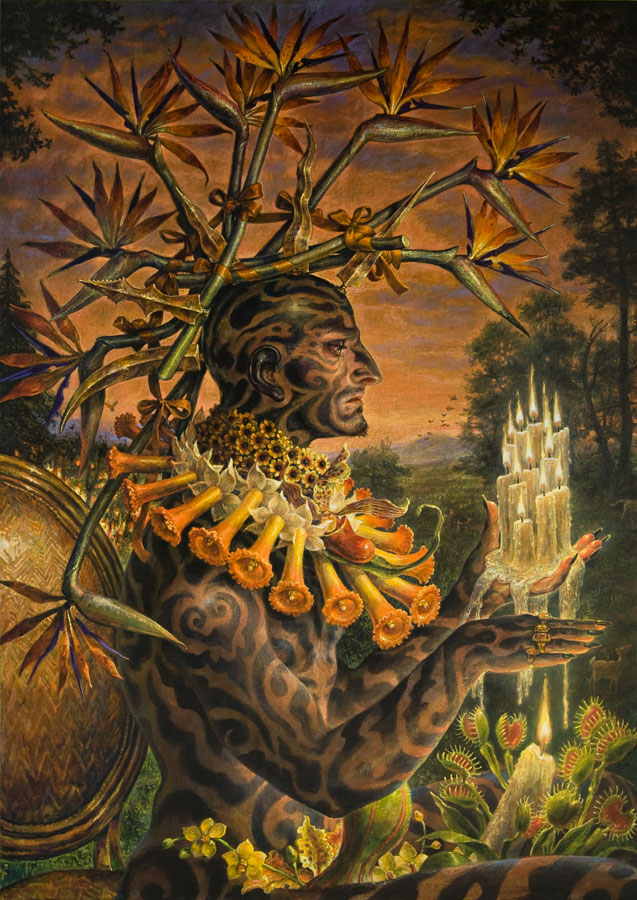
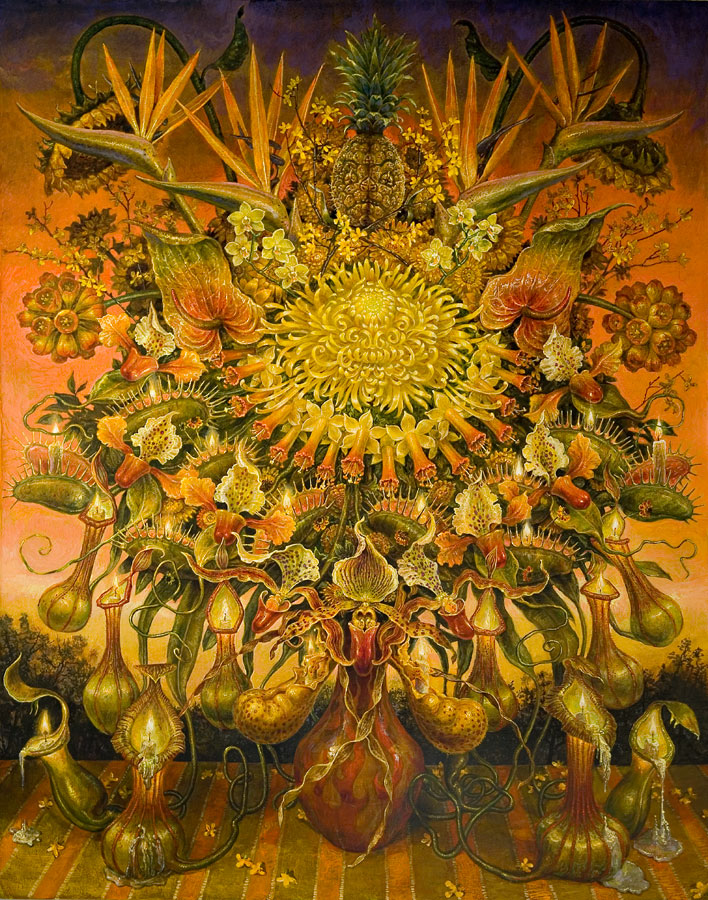
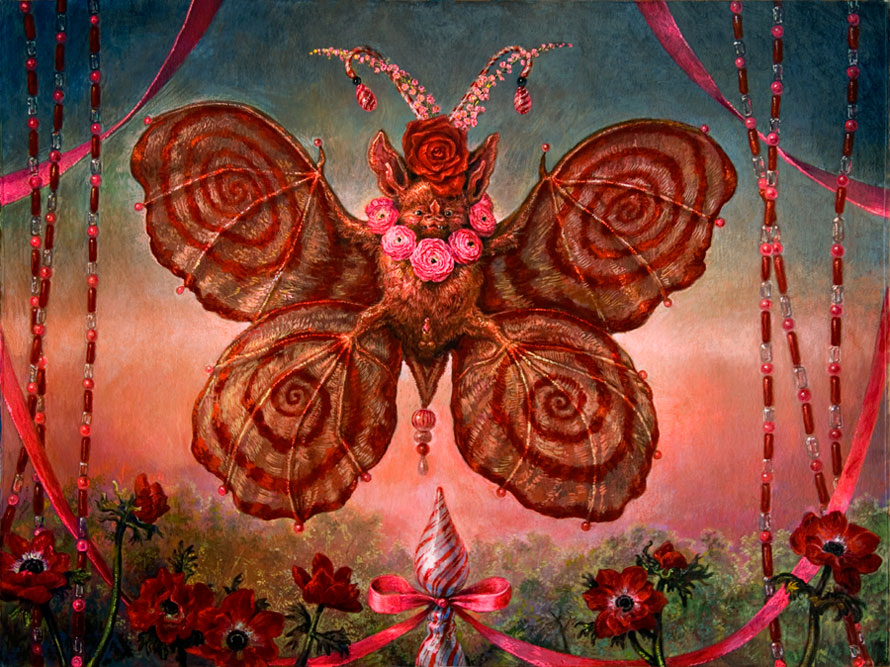
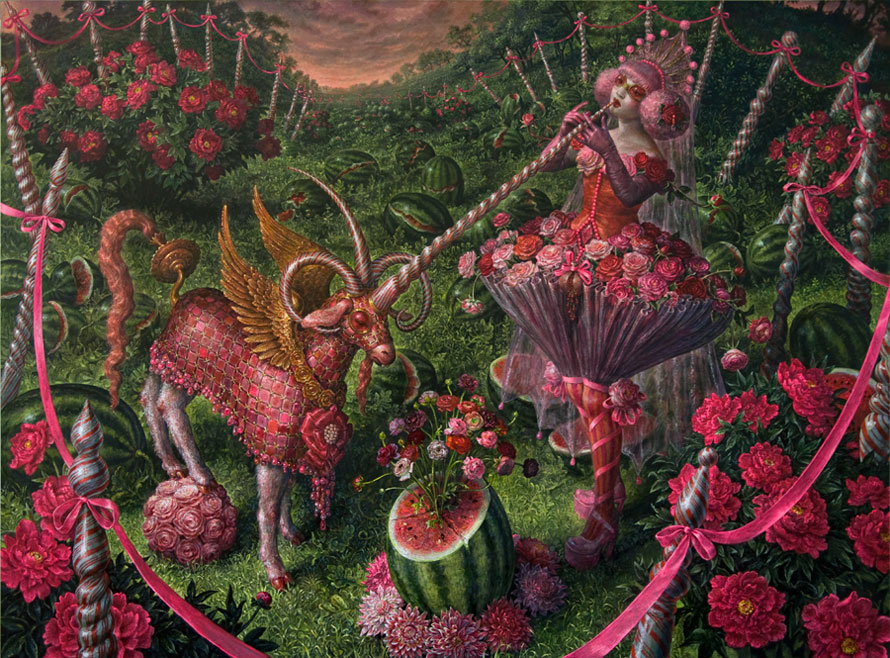
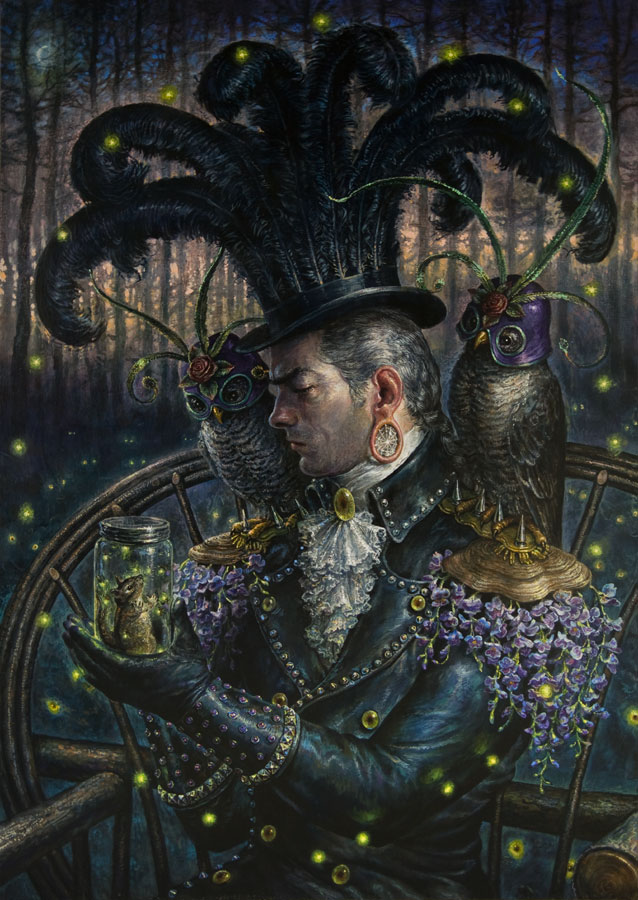
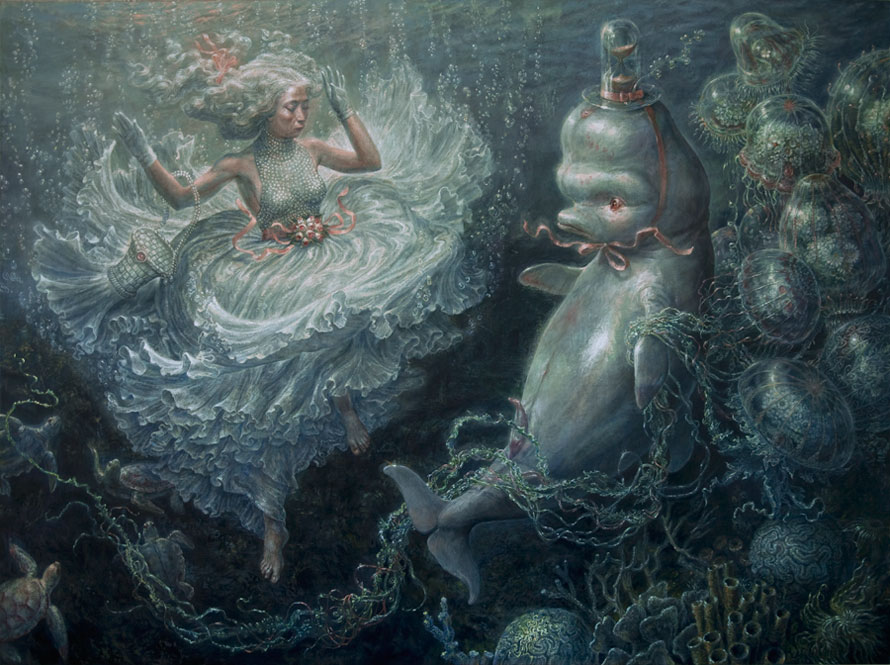
Interview continued
The other terms of “pop surrealism” and “low brow” are not appropriate to imagist painters of my stripe who are trying to do something sophisticated and complex using the vocabulary and language of pictures as their content. I got tired of being referred to as something I was not, and I started calling myself a Neo-Fabulist several years ago.
Contemporary artists who could fit into this category are Vincent Desiderio (who wrote a lovely essay for this exhibition) and artists like Walton Ford, Tom Knechtel, and Carole Caroompas as elder statesmen, but there are many artists, old and young, all over the world who would be better classified as “Neo-Fabulist” than any other artistic grouping. I hope it catches on. The punning with the word “Fabulous” also amuses me a great deal!
TMN: I remember learning about Hippocrates’s theory of the four humors, but honestly I’d forgotten about them until I saw these paintings. What drew you to base this series of paintings around them?
TW: My work has explored secret systems and forgotten medical and scientific theories in the past. For example, I have done work using alchemical imagery, Masonic and odd fellow symbols, and tattoo iconography. There are intriguing interpretations of the temperaments throughout the history of pictures, and I wanted to see how I could interpret them today. Blake had the image of Durer’s engraving “Melancholia” hanging over his bed for most of his life. I like being able to continue this artistic conversation.
TMN: In some ways the fact that this is outdated, archaic science gives it even more imaginative power. How did you discover or develop the associations between image and humor or color?
TW: There is much in the temperament theory that is predescribed, and I love having rules to my pictorial game. The colors (yellow, red, black, white) are determined, as are the elements (air/blood, fire, earth, water). For me, I can always be more creative when there are formal constraints to contend with. I always try to research my theme, and in that period of research, images begin to become clear to me.
TMN: Do you identify or relate to the theory of humors personally? Do you think about your development or emotions in terms of these temperaments?
TW: In living immersed in the temperaments for three years, I did see how they helped me think about my own emotional state and the states of others. I am a Chair at the School of Visual Arts, and often must deal with students in highly heightened emotional conditions. As one gets older, there is a need to keep you temperaments in balance, and although I have not yet perfected this trick, I am hopefully more aware of it!
It’s akin to astrology, it’s helpful if you want allow it to be. I like phrenology too.
TMN: How did the themes and images in the paintings develop? How do the batterflies and beasties relate to the landscapes?
TW: I was interested in setting the temperaments in various formats: Portrait, Still Life, and Landscape. In the Landscape Variation, I wanted to explore the intriguing trope of the “woman and beast.” The Sanguinic painting was inspired by the unicorn tapestries, the choleric was a hybrid of Delacroix and Rousseau’s “Sleeping Gypsy,” the melancholic was inspired by the German Romantics and the Symbolists, the Phlegmatic by the American Tonalists with a dollop of Disney. The beasts would be benign, dangerous, fearsome, and enigmatic: all the things that beasts could be. The Batterfly and Beastie variations were developmental experiments before I completed the larger works, using the rules to the game I described above. The process sounds a bit clinical, but it is not, in the studio I allow the flight of fancy, and every decision makes sense as one idea leads into another…what is the best outfit for the quadicorn to be dressed in? What kind of a crown should the red tiger wear? How can the black beads be incorporated into this image? Can the batterfly have vulnerability and human traits imposed on his beastliness? etc. I determine a vocabulary of “stuff” that is then re-used and transformed in different ways in the different images as a poet uses a leitmotif.
TMN: I love that you pair mysterious, antiquated themes with modern imagery—piercings, and tattooed folks, etc. It’s something I notice throughout your work—how important is the connection to history?
TW: In our age we have easier access to the history of images than any other artists before us. There is no excuse for someone not to be well versed and visually educated if they intend to communicate with images. I have trained myself to have technical prowess which now seems natural, but I am not interested in my work looking “old masterish,” it was never a concern of mine. I am interested in the mysterious, powerful, and magical. Other artists from the past and in all cultures have been drawn to the same emblematic and dreamy way of creating pictures. I think of these artists as a kind of posse of comrades, and I felt their presence in my studio, to help me have their courage. Modern imagery or antiquated imagery is pretty much the same to me; it is their combination to create atmosphere, feeling, and a memorable picture that is the important goal.
TMN: These paintings remind me of so many really visual literary works—The Jungle Book, “The Owl and the Pussycat,” Grimm’s Fairy Tales, and of course William Blake. Is there a story here, or even a fictional world you’re representing?
TW: What interests me is telling a story without really telling the whole story. Illustrators often give everything away, leaving the viewer with little to do but absorb the information. I like to make paintings that are harder to unravel, and don’t have set morals as in examples of children’s literature you’ve cited. I am using the vocabulary of the fantastical, and that will draw you into the world, but once you are there, hopefully things are not exactly what you may have expected. There is no before or after in these images. The old blind tiger will never bite off the anime warrior girl’s foot, and she will never be able to kill him, no matter how many knives she has at her disposal. It is an iconic struggle with no trick ending. There is a fully formed cosmology to the world, yes, but only for the purpose of making the tableau fully realized, the picture operates on a different level—both characters are me, or aspects of me, and hopefully the viewer will feel the same way. That is the only narrative thrust that is needed. This is what makes painting different from literature.
TMN: In the work of yours I’ve seen there’s beauty in things strange and unusual, of course, but I also get this sense of things too fragile for this world. Are the humors about vulnerability in some way or is that just me pathologizing them?
TW: In many was I am terribly out of step with much of what is being made in the art world: maggots in vitrines, endless spots, work being proudly outsourced to assistants in third-world countries, naked people standing motionless in doorways for hours, cold rusted iron walls… We seem to be able to accept everything as serious art, except that which deals with emotion or sentiment, which becomes denigrated immediately as “kitsch.”
My humble enterprise is all made by hand, all made by me alone, and is an attempt to feel something through the brush and the pigments about what it’s like for me to be alive at this moment. It’s about as simple a practice as you can get, and for me it is endlessly interesting and challenging. Sure, it’s about fragility and vulnerability. You bet. Absolutely. We all put on our brave faces, our cute little outfits, comb our hair, suck in our guts, and try to proceed as best we can (with our humors often getting in our way). Every day I set out in search of the beautiful, or the humanistic, or hopefully both at the same time. Sometimes I fail, but I feel it is the artist’s job to distill these things: the grand and bland, the noble and the pathetic, the brilliant and the dark, and try to make some kind of sense or logic to it all.
